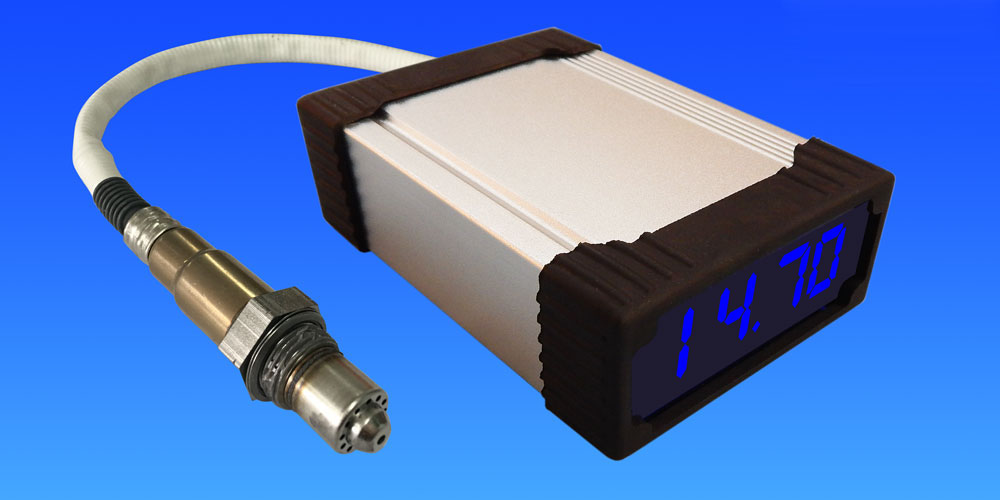 ALM-LED (Accurate Lambda Meter with LED display)
ALM-LED (Accurate Lambda Meter with LED display)
ALM (Accurate Lambda Meter) is an air-fuel-ratio (AFR) meter which uses the Bosch LSU4.9 wideband oxygen sensor and Bosch semiconductor chip CJ125 to accurately measure the AFR or lambda for variant combustion engines. ALM-LED is a version of ALM that has a build-in LED display instead of a separate gauge. This version has all the ALM functions plus the built-in LED and the rugged enclosure which make it perfectly an engine tuning instrumentation either in the lab environment or in the vehicle. The LED display is very bright and even striking directly under the sun. There are 4 digits, including 2 digits floatï¼› compare to typical 3 digit after market gauges. It can be configured to display AFR, Lambda, or O2 concentration. The advantage of ALM-LED: save you a gauge, and make the whole package more compact, higher resolution of the display, and the configurable display variable. In some applications, you don't have a console to mount your round gauge. This LED box is perfect to sit anywhere flat. Again, all our ALMs have the high accuracy and fast response characteristics, which are the root of our design at the very beginning. First, ALM uses the more advanced LSU4.9 sensor instead of a LSU4.2 which is still used by most other wideband controllers. LSU4.9 is the new generation wideband sensor. It is superior to LSU4.2. One obvious proof is: Bosch uses LSU4.9 across the board for their wideband applications. (See the appendix: LSU4.2 vs LSU4.9) Click here to see why LSU 4.9 is superior to 4.2 Second, Bosch chip CJ125 is the integrated chip (IC) specifically designed for LSU 4.9/4.2 Sensors. Bosch's own wideband controller, "LambdaTronic", uses CJ125 driver chip. In fact, Bosch uses this chip wherever a LSU sensor is used. The CJ125 and LSU sensor are mated-pair by Bosch. Presumably LSU sensors work the best with CJ125 chips. Together, LSU 4.9 and CJ125 make our ALM a more accurate lambda meter in the automotive aftermarket.
Click here for some news on customer applications
Click here to see a successful story of an OEM multi-fuel engine application
List of ALM-LED parts
Small ALM controller
built-in LED display
Harness (1.5 meter default, 3 meter optional)
Bosch LSU 4.9 sensor
Sensor plug and bung
Serial communication cable
USB to serial converter (included)
CD - documents and ALM-GUI software
ALM technical specifications
Power supply
Input voltage range: DC 9V~15 V (12V Typical)
Input current: 50mA typical plus the heater current
Voltage protection : Reverse polarity protected, & overvoltage protected
Load Dump Clamp : Maximum voltage
Sensors
Compatible: LSU4.9 (LSU 4.2 capable but not recommended)
Number of Sensors: One
Free air calibration: No need (it measures the free air)
Measurement
Lambda range: λ = 0.55 ~ ∞ (Gasoline AFR: 8.08 to free air)
Lambda accuracy: ±0.008 @ λ=1.00
±0.01 @ λ=0.80
±0.05 @ λ=1.70
Air/Fuel Ratio: Fuel dependent (see lambda range and accuracy)
Response time
5ms updating rate (everything finished in 5ms)
Heater
Control built-in PID control with CJ125
Current Typical 1A; Max 1.5A
Heater return (H-) Separate wire from Ground
Output
Lambda analog output: 0~5V user programmable
Analog accuracy: ±0.005V error with a 10-bit DAC chip
Analog type: Reference ground to ECU
second Lambda analog output: 0~5V for a third party gauge, user programmable
Communications
advanced CAN bus communication (optional)
RS232 or USB (via an adaptor) for logging or programming
User-friendly PC software for data acquisitions and analysis
Display
4 digit LED display
including 2 digit floating numbers
AFR, lambda, O2% configurable
Main-Processor
CPU: FreeScale 16-bit micro-processor S12P (auto industry rated)
Speed: 32MHz
Memory: 128k Flash, 6k Ram, 4k Data
Load Dump Clamp
Maximum voltage
Special features
On-Board-Diagnosis and error report
Self-learning of part-to-part variations, aging effect
Working with different types of fuels (gasoline, diesel, E85, etc)
General
Temperature range: -45C ~ +125 C (can be installed in the engine compartment)
Dimensions: 4" x 2.6" x 1"
 ALM-LED Manual-V2.6
ALM-LED Manual-V2.6 
 ALM Communication Protocol - CAN- v1.9
ALM Communication Protocol - CAN- v1.9 
 ALM GUI User Manual - v1.3
ALM GUI User Manual - v1.3  software
software
 ALM GUI Setup - v2.9.16
ALM GUI Setup - v2.9.16
| Characteristics | LSU4.2 | LSU4.9 | Notes |
| lambda range | lambda = 0.65 ~ ∞ | lambda = 0.65 ~ ∞ | |
| Accuracy | only good at lambda = 1 or moderate rich |
accurate at both rich and lean, wider range |
LSU4.2 is only accuracy at lambda = 1 and moderate rich, between 0.8~1.0 lambda; LSU4.9 has better accuracy in both rich and lean conditions, suitable for gasoline, diesel, CNG, etc. |
| Response time | Slower | Faster | Thinner sensing element of LSU 4.9 makes it more responsive to the AFR change, dynamically more accurate, and easier to light off, less heating power needed. |
| Heating power | 10W | 7.5W | LSU4.2 has the off-centered-heater vs. LSU 4.9 has the centered-heater in the laminate; LSU4.9 has better heating efficiency, less heating power needed. |
| Free air calibrations |
needed | not needed | LSU4.2 is susceptible to reference air contaminations, which is called CSD (characteristic shift down), requires frequent free-air calibrations. LSU4.9 uses reference pump current instead of reference air. No more CSD. No requirement of free-air calibrations |
| Nernst cell resistance vs. temperature |
80~750C | 300~790C | LSU4.9 has higher resolution of internal resistance vs. temperature characteristics, which makes the temperature measurement more accurate, and better heater control, therefore higher accuracy of lambda. |
| Light off time | long | short | LSU4.9 lights off faster. Lambda controls can be active much faster during warm up phase. |
| Reliability | Improved reliability | LSU4.9 is superior to LSU4.2 with regard to the reliability and life. | |
| Check with Bosch | Still selling it | Recommended | Bosch recommends LSU4.9 to all OEMs. Bosch uses LSU4.9 for its own wideband controller. http://www.bosch-motorsport.de/media/catalog_resources/Lambdatronic_LT4_Datasheet_51_en_2785631627pdf.pdf |
Please contact us at info@ecotrons.com for purchase and other inquiries.







